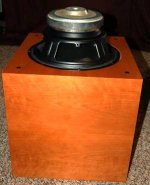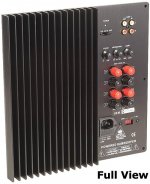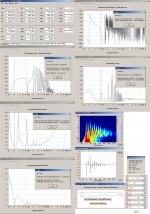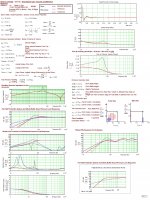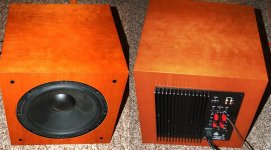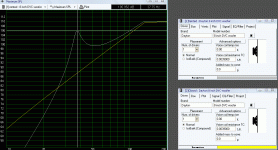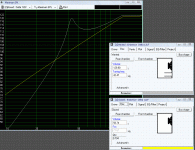Need some help.
I have a generic 12" woofer (someone's prototype driver that I picked up cheap), and have the parameters, but need help with a vented alignment.
The parameters are:
Fs: 23.55 Hz
SPL: 89.89 dB 2.83 V/1m, 90.5 dB 1W/1m
Vas: 6.551 cu. ft.
Cms:0.0901 in/lb
Mms: 3.132 oz
Rms: 7.358 lb/s
Re: 9.207 ohms
Le: 2.836 mH
Z=11.05 ohms
BL: 4.231 lb/A
Pe: 150 Watts
No: 0684%
Qms: 3.936
Qes: 0.341
Qts: 0.314
Xmax: 0.42 in (11mm)
Xmech: 0.63 in (16mm)
P-Dia: 9.972 in
Sd: 78.1 sq.in
P-Vd: 0.019 cu. ft
The box I have is a 15" cube. It has 0.75" walls and a 1"x2" cross brace through the center. I calculate the gross volume at 1.4 cu. ft., but the woofer itself takes up some volume, as it juts 4" into the box, and has a 7" dia. magnet(see pic), so the net(actual) volume is is probably closer to 1.25 cu.ft.
Anybody here to give a recommendation for box frequencies and vent length (I do have some 2" i.d. PVC pipe on-hand) ?
I have a generic 12" woofer (someone's prototype driver that I picked up cheap), and have the parameters, but need help with a vented alignment.
The parameters are:
Fs: 23.55 Hz
SPL: 89.89 dB 2.83 V/1m, 90.5 dB 1W/1m
Vas: 6.551 cu. ft.
Cms:0.0901 in/lb
Mms: 3.132 oz
Rms: 7.358 lb/s
Re: 9.207 ohms
Le: 2.836 mH
Z=11.05 ohms
BL: 4.231 lb/A
Pe: 150 Watts
No: 0684%
Qms: 3.936
Qes: 0.341
Qts: 0.314
Xmax: 0.42 in (11mm)
Xmech: 0.63 in (16mm)
P-Dia: 9.972 in
Sd: 78.1 sq.in
P-Vd: 0.019 cu. ft
The box I have is a 15" cube. It has 0.75" walls and a 1"x2" cross brace through the center. I calculate the gross volume at 1.4 cu. ft., but the woofer itself takes up some volume, as it juts 4" into the box, and has a 7" dia. magnet(see pic), so the net(actual) volume is is probably closer to 1.25 cu.ft.
Anybody here to give a recommendation for box frequencies and vent length (I do have some 2" i.d. PVC pipe on-hand) ?
Attachments
Wrong.
Ported boxes roll off at 24dB per octave. Not only does this take a huge amount of power to compensate, but, when the driver has rolled off, it is not loaded by the box, so you get lots of excursion but relatively little sound output. Most people put a high pass filter on them to keep excursion to sane levels, but you're going to boost it instead?
If you kept the box sealed, you could play around with bass boost, because the cabinet loads the driver all the way down to 0Hz, so it prevents the huge excursion.
Chris
Ported boxes roll off at 24dB per octave. Not only does this take a huge amount of power to compensate, but, when the driver has rolled off, it is not loaded by the box, so you get lots of excursion but relatively little sound output. Most people put a high pass filter on them to keep excursion to sane levels, but you're going to boost it instead?
If you kept the box sealed, you could play around with bass boost, because the cabinet loads the driver all the way down to 0Hz, so it prevents the huge excursion.
Chris
Wrong.
Ported boxes roll off at 24dB per octave. Not only does this take a huge amount of power to compensate, but, when the driver has rolled off, it is not loaded by the box, so you get lots of excursion but relatively little sound output. Most people put a high pass filter on them to keep excursion to sane levels, but you're going to boost it instead?
If you kept the box sealed, you could play around with bass boost, because the cabinet loads the driver all the way down to 0Hz, so it prevents the huge excursion.
Chris
If the 1.25ft3 reflex box is tuned to ~30Hz then it'll need about 7dB of bass boost to flatten the response, then a fast rolloff (HPF) below this to prevent high excursion when unloaded -- you can probably do both with an underdamped 2nd order HPF, but to get a really flat response you will probably need more complex parametric equaliser (as well as a HPF).
The Xmax-limited maximum output of a reflex box is about 8dB higher than an Xmax-limited closed box (or 2/3 octave more extension for the same SPL), and the efficiency near cutoff is usually higher as well.
Hey Chas!
Looks like you are finally getting around to putting those goods to use!
Here is my take on a vented sub with the driver:
1. A 2" port is too small for a 12" driver
2. The volume of the enclosure is too small. The response will not be any better than what you can achieve if you use it sealed.
So - I recommend that you use it sealed. You would get the following response (unstuffed):
Q = 0.75
Fb = 59Hz
F6 = 45Hz
Adding some stuffing will reduce Q a little and will help to reduce internal reflections, etc.
Still not great as Fb is rather high. In that case, one of those plate amps that has a 30Hz boost of +6dB would be a great match for this speaker + sealed box combo. You could then get pretty flat response down to around 30Hz, where the room boost will kick in.
I think that this amp will pretty much drop in to the cutout in the back:
MnK Amp
It would be a good match to the driver and cabinet.
If you want to chat about it a little, send me a mail here or to the DIY group web site.
-Charlie
Looks like you are finally getting around to putting those goods to use!
Here is my take on a vented sub with the driver:
1. A 2" port is too small for a 12" driver
2. The volume of the enclosure is too small. The response will not be any better than what you can achieve if you use it sealed.
So - I recommend that you use it sealed. You would get the following response (unstuffed):
Q = 0.75
Fb = 59Hz
F6 = 45Hz
Adding some stuffing will reduce Q a little and will help to reduce internal reflections, etc.
Still not great as Fb is rather high. In that case, one of those plate amps that has a 30Hz boost of +6dB would be a great match for this speaker + sealed box combo. You could then get pretty flat response down to around 30Hz, where the room boost will kick in.
I think that this amp will pretty much drop in to the cutout in the back:
MnK Amp
It would be a good match to the driver and cabinet.
If you want to chat about it a little, send me a mail here or to the DIY group web site.
-Charlie
CharlieLaub wrote:
Thanks, Charlie!
SteveO was kind enough to take time out of his busy schedule to measure a woofer for me, but that sub box wound up being smaller than 1.6 cu.ft, so the vented alignment he gave for that volume won't be right.
The plate amp I have is from Parts Express(Pic attached), which I remember was specified with +6dB boost at 30Hz. I believe this is the same unit as the M&K unit (which was no doubt rebranded for them).
I'll send you mail, once I check out the amp.
-Chas
I think that this amp will pretty much drop in to the cutout in the back:
MnK Amp
would be a good match to the driver and cabinet.
Thanks, Charlie!
SteveO was kind enough to take time out of his busy schedule to measure a woofer for me, but that sub box wound up being smaller than 1.6 cu.ft, so the vented alignment he gave for that volume won't be right.
The plate amp I have is from Parts Express(Pic attached), which I remember was specified with +6dB boost at 30Hz. I believe this is the same unit as the M&K unit (which was no doubt rebranded for them).
I'll send you mail, once I check out the amp.
-Chas
Attachments
My quick calcs say you need a 2.9 ft^3 box tuned to 30 Hz to give flat response with an f3 of 33 Hz. IMO, anything you build in a 1.25 ft^3 box will be a mess.
Hi Conrad, Agree 100%, As Vas for this driver is about 185 L and a 1.25 cu.ft. is only ~35 L the closed volume Qt seen by the driver is above 0.77: The result if trying to add ports would turn this speaker at most, into a very mediocre mid bass with in band rippled FR.
See a sub design using this driver that IMO would work well as a sub:
b
Last edited:
IMO, it could be done sealed, but the necessary eq would be more complex than should be attempted without a lot of test equipment.
I'm sure the driver and box are just fine, but they're a poor match and "fixing" it in the electronics won't result in anything good enough to justify the effort. Why not make another box of the correct size?
FWIW, I had this very same type of thing in my system for a long time- 10" drivers in somewhat small sealed enclosures. The enclosures were about the right size for a sealed system, but the drivers, like these, really wanted to be in larger vented enclosures. When the surrounds rotted out I tossed both boxes and drivers and replaced them with some nice 8" drivers in correctly sized sealed enclosures. They're better in every way than the old 10" drivers. You just can't arbitrarily put a given driver in a vented or sealed box and, IMO, the selection of big drivers that can work well in sealed enclosures is surprisingly small.
I'm sure the driver and box are just fine, but they're a poor match and "fixing" it in the electronics won't result in anything good enough to justify the effort. Why not make another box of the correct size?
FWIW, I had this very same type of thing in my system for a long time- 10" drivers in somewhat small sealed enclosures. The enclosures were about the right size for a sealed system, but the drivers, like these, really wanted to be in larger vented enclosures. When the surrounds rotted out I tossed both boxes and drivers and replaced them with some nice 8" drivers in correctly sized sealed enclosures. They're better in every way than the old 10" drivers. You just can't arbitrarily put a given driver in a vented or sealed box and, IMO, the selection of big drivers that can work well in sealed enclosures is surprisingly small.
Last edited:
See a sub design using this driver that IMO would work well as a sub:
b
Attachments
If the 1.25ft3 reflex box is tuned to ~30Hz then it'll need about 7dB of bass boost to flatten the response, then a fast rolloff (HPF) below this to prevent high excursion when unloaded -- you can probably do both with an underdamped 2nd order HPF, but to get a really flat response you will probably need more complex parametric equaliser (as well as a HPF).
The Xmax-limited maximum output of a reflex box is about 8dB higher than an Xmax-limited closed box (or 2/3 octave more extension for the same SPL), and the efficiency near cutoff is usually higher as well.
There's also an excursion peak 1/2 octave above port tuning. That would cause problems (45Hz is within the kick drum and bass guitar range).
You can't go saying that you get 8dB more out because, when tuned to 50Hz, a sealed box will have loads more output at 10Hz, using less excursion.
Chris
PS - putting a second order LP filter on it set to 20Hz would get it to go low (keeping it sealed), but efficiency is through the floor.
There's also an excursion peak 1/2 octave above port tuning. That would cause problems (45Hz is within the kick drum and bass guitar range).
You can't go saying that you get 8dB more out because, when tuned to 50Hz, a sealed box will have loads more output at 10Hz, using less excursion.
Chris
PS - putting a second order LP filter on it set to 20Hz would get it to go low (keeping it sealed), but efficiency is through the floor.
OK, I'll be more precise -- at the box tuning frequency or above, a reflex has 8dB more Xmax-limited output than a closed box with the same driver.
Yes there is an excursion peak 1/2 octave above the port tuning, but the excursion here is the same as a closed box with a 3dB cutoff 2/3 octave higher than the reflex.
I'm struggling to see where this 8dB more output has come from. Using a generic 8" driver, in a 19L sealed box, Q=0.707, f3=70Hz and vented 34L tuned to 37Hz gives an f3 of 40Hz. Using the max.SPL tab on winISD, the ported one, at tuning frequency, can put out over 20dB more. Below 25Hz, the sealed one has a higher maxSPL. Above tuning, the SPL increase is very slight (6dB, but the difference narrows quickly as the port becomes inactive). I fail to see where 8dB comes in to it (an average, perhaps?).
Anyway, the conclusion seems to be go for sealed here, as vented boxes need to be much bigger than that cabinet.
Chris
Anyway, the conclusion seems to be go for sealed here, as vented boxes need to be much bigger than that cabinet.
Chris
I'm struggling to see where this 8dB more output has come from. Using a generic 8" driver, in a 19L sealed box, Q=0.707, f3=70Hz and vented 34L tuned to 37Hz gives an f3 of 40Hz. Using the max.SPL tab on winISD, the ported one, at tuning frequency, can put out over 20dB more. Below 25Hz, the sealed one has a higher maxSPL. Above tuning, the SPL increase is very slight (6dB, but the difference narrows quickly as the port becomes inactive). I fail to see where 8dB comes in to it (an average, perhaps?).
Anyway, the conclusion seems to be go for sealed here, as vented boxes need to be much bigger than that cabinet.
Chris
If you ignore the frequency response and just apply as much power as necessary to reach Xmax -- this may be more or less than the thermal rating of the driver -- then above the box tuning you can typically get about 8dB more output (at the maximum excursion frequency) from a reflex than a closed box, this could be a bit more or a bit less depending on the driver and box used.
Since each extra octave needs 4x the excursion, 8dB means 2/3 of an octave extension without being Xmax limited (if the example you chose had 6dB this would give 1/2 an octave). To pick an example, the 10" driver I use in our band's PA (Celestion BN10-300X) will handle 300W down to about 125Hz (-3dB point) in a closed box or 80Hz (-3dB point) in a reflex before Xmax is exceeded. You don't want to be using high-Q drivers in this case.
You can build a reflex in a small box which works down to <40Hz, but you need a suitable driver (e.g. Ciare 12.00SW) and long ports with enough area to prevent port noise -- this can mean about 500mm long, but you can use drainpipe bends to get more length in. Of course there are limits, once the ports start occupying a significant part of the box volume you're onto a long slippery slope...
For low tuning in a small box passive radiators have advantages, but you have to find them and then build them into the box.
And of course if the driver has lots of Xmax and not so much power handling (which could be the case for this one), you won't run out of Xmax in a closed box anyway
Last edited:
Need some help.
..generic 12" woofer.. need help with a vented alignment..
The parameters are:
Fs: 23.55 Hz
SPL: 89.89 dB 2.83 V/1m, 90.5 dB 1W/1m
Vas: 6.551 cu. ft.
Cms:0.0901 in/lb
Mms: 3.132 oz
Rms: 7.358 lb/s
Re: 9.207 ohms
Le: 2.836 mH
Z=11.05 ohms
BL: 4.231 lb/A
Pe: 150 Watts
No: 0684%
Qms: 3.936
Qes: 0.341
Qts: 0.314
Xmax: 0.42 in (11mm)
Xmech: 0.63 in (16mm)
P-Dia: 9.972 in
Sd: 78.1 sq.in
P-Vd: 0.019 cu. ft
.. so the net(actual) volume is is probably closer to 1.25 cu.ft...
..Anybody here to give a recommendation for box frequencies and vent length ..
Fyi,
b

Attachments
Good results!
CharlieLaub wrote:
Since I'm using this to extend the low end of my small monitors, primarily for music (not as a LFE sub), I took your advice and used it sealed.
I've fine-tuned the plate amp with bass boost almost an octave below fb cutoff. The end result is very nice, tight bass in my room without over-excursion (at the levels I prefer).
Thanks again to everyone here for all your help!
-Chas
p.s. I was originally advised to use it in a vented box, but the box I got turned out to be much smaller than was required for this; Consequently, an equalized sealed box was the answer.
CharlieLaub wrote:
I recommend that you use it sealed...In that case, one of those plate amps that has a 30Hz boost of +6dB would be a great match for this speaker + sealed box combo. You could then get pretty flat response down to around 30Hz, where the room boost will kick in.
Since I'm using this to extend the low end of my small monitors, primarily for music (not as a LFE sub), I took your advice and used it sealed.
I've fine-tuned the plate amp with bass boost almost an octave below fb cutoff. The end result is very nice, tight bass in my room without over-excursion (at the levels I prefer).
Thanks again to everyone here for all your help!
-Chas
p.s. I was originally advised to use it in a vented box, but the box I got turned out to be much smaller than was required for this; Consequently, an equalized sealed box was the answer.
Attachments
Last edited:
If you ignore the frequency response and just apply as much power as necessary to reach Xmax -- this may be more or less than the thermal rating of the driver -- then above the box tuning you can typically get about 8dB more output (at the maximum excursion frequency) from a reflex than a closed box, this could be a bit more or a bit less depending on the driver and box used.
winISD has the capability to model the Xmax-limited SPL.
See below - the first is using a generic 8" subwoofer, with recommended cabinet volumes etc, here's the maximum SPL. At 130Hz and below, it's Xmax limited, at above that, it's power limited.
The second one is with an Eminence Delta 12LF.
Edit - nice sub above. Wish mine looked like that.
Attachments
Last edited:
Off Topic- Hot Electrolytic caps in PS?
I finally got around to testing anotherof the plate amps, and upon powering this one up, the 4A line fuse blew after a second or so. I touched the two "Jun Fu" 6800uf electrolytic caps and they felt unusually warm for such a short power-up.
To be sure it wasn't just a turn-on surge, I slowly powered it up through a variac. The fuse didn't blow this time, but the caps felt
very hot !
Looks like I'll have to replace them anyway, after all.
Anyone else have this experience with these caps?
Recommendations?
-Chas
p.s. I tried to contact Steve at Apex Jr., regarding the Jun Fu caps(he sells these), but he's away on vacation for another week.
I finally got around to testing anotherof the plate amps, and upon powering this one up, the 4A line fuse blew after a second or so. I touched the two "Jun Fu" 6800uf electrolytic caps and they felt unusually warm for such a short power-up.
To be sure it wasn't just a turn-on surge, I slowly powered it up through a variac. The fuse didn't blow this time, but the caps felt
very hot !
Looks like I'll have to replace them anyway, after all.
Anyone else have this experience with these caps?
Recommendations?
-Chas
p.s. I tried to contact Steve at Apex Jr., regarding the Jun Fu caps(he sells these), but he's away on vacation for another week.
Caps rattle when shaken(bad sign)
I removed the suspect caps and upon shaking them they rattle as if there is something loose inside. Other electrolytics on hand do not exhibit this.
Ill assume they have "dried-out" and that's why they are bad(?).
I'm now shopping for some good quality 80V snap-ins...
-Chas
I removed the suspect caps and upon shaking them they rattle as if there is something loose inside. Other electrolytics on hand do not exhibit this.
Ill assume they have "dried-out" and that's why they are bad(?).
I'm now shopping for some good quality 80V snap-ins...
-Chas
- Status
- This old topic is closed. If you want to reopen this topic, contact a moderator using the "Report Post" button.
- Home
- Loudspeakers
- Subwoofers
- Help with vented box alignment?
